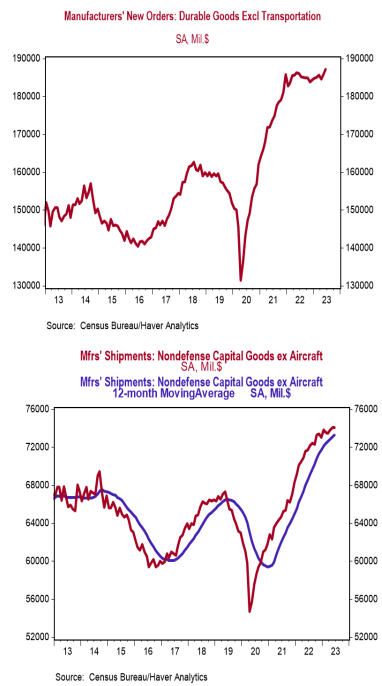- New orders for durable goods rose 4.7% in June (+4.9% including revisions to prior months), easily beating the consensus expected gain of 1.3%. Orders excluding transportation rose 0.6% (+0.7% including revisions), versus a consensus expected +0.1%. Orders are up 8.9% from a year ago, while orders excluding transportation have risen 0.5%.
- Rising orders for commercial aircraft and fabricated metal products led gains across all major categories.
- The government calculates business investment for GDP purposes by using shipments of non-defense capital goods excluding aircraft. That measure was unchanged in June but rose at a 1.9% annualized rate in Q2 versus the Q1 average.
- Unfilled orders rose 1.8% in June and are up 6.7% in the past year.
Implications:
No matter how you cut it, durable goods orders handily beat expectations in June as new orders rose 4.7% (versus a consensus expected +1.3%), while prior months data was revised higher as well. The increase in orders was led by the typically volatile commercial aircraft category, which surged 69.4% in June. But even stripping out transportation, orders still rose a robust 0.6% with gains across all major categories. Diving into the details shows orders for both electrical equipment and computers & electronic products rose 1.5% in June, while orders for fabricated metal products increased 1.3% and primary metals rose 0.9%. One of the most important numbers in today’s report is core shipments – a key input for business investment in the calculation of GDP – which was unchanged in June but rose at a 1.9% annualized rate in the second quarter versus the Q1 average (for more information about economy-wide growth in the second quarter, see today’s Q2 GDP release). While still positive in Q2, this is the fifth consecutive quarterly deceleration in the pace of growth and represents the weakest quarter since the COVID shutdown-restricted second quarter of 2020. In the past year, orders for durable goods are up 8.9%, while orders excluding transportation are up more modest 0.5%. But when you consider that producer prices for capital equipment are up 4.5% in the past year, it means that orders outside the transportation sector have declined when adjusted for inflation. A number of factors are likely to generate turbulent footing as we continue further into 2023: a tighter Federal Reserve, the tightening of lending standards following stress in the banking sector, and withdrawal symptoms following the COVID-era economic morphine that artificially boosted both consumer and business spending. In addition, the return toward services means a large portion of goods-related activity will soften in the year ahead, even as some durables that facilitate services recover. While the data to-date shows continued economic growth, we believe a recession awaits us later this year or early in 2024. In employment news this morning, initial claims for jobless benefits fell 7,000 last week to 221,000. Meanwhile, continuing claims fell 59,000 to 1.690 million. These figures suggest continued job growth in July.





